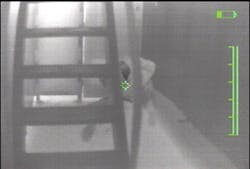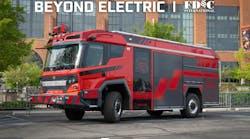Every month, this column emphasizes how a thermal imager (TI) can make a firefighter’s job easier and safer. This month’s column is the first installment of a three-part series that concentrates on training firefighters to use their TIs in a safe, competent manner. Departments must train on general safety principles to ensure that their members do not become overconfident with or overly reliant on thermal imagers.
Five Deadly Sins
As with any tool in the fire service, if a TI is misused, the consequences can be disastrous for the user. Therefore, firefighters using TIs must understand the five general risks of TI use and how to avoid their traps.
The "Five Deadly Sins" in thermal imaging are:
1. Standing and Walking in Unsafe Environments
2. Abandoning Traditional Safe-Search Techniques
3. Advancing at an Inappropriate Speed
4. Misinterpreting Images
5. Misapplying Technology
Standing and Walking in Unsafe Environments
Unfortunately, this sin is one of the most common. Firefighters are trained to stay low, crawling in hostile environments to avoid exposure to heat and unseen dangers. Thirty years ago, firefighters had to stay low in fire. Their protective equipment was not advanced enough to provide respiratory and thermal protection from aggressive fires. Modern turnout gear, though, is durable enough to allow firefighters to stand and walk in all but the hottest environments. Fire instructors prove this regularly when they walk around burning buildings, guiding their crawling students through their drills and to the fire.
Now the inability to see is the primary external force that pushes modern firefighters to crawl. To avoid injury, firefighters crawl to navigate around furniture and debris, up and down stairs, and around any hazards that might exist in a structure. When equipped with a TI, however, firefighters have the ability to "see" their environment, which fosters a natural tendency to assume that a structure can be safely navigated on foot.
The tendency to stand and walk in hazardous environments can have dangerous consequences. Superheated gases are still present and pose serious risks to the firefighter and his equipment. Certain hazards may be difficult to differentiate on a thermal imager, such as a hole in the floor of an abandoned building, or furniture in a temperature-stable room. Also, thermal imagers lack a critical aspect of human perception: peripheral vision. Peripheral vision helps firefighters identify structural risks even when they are not staring directly at them. A thermal imager will not detect a potential risk unless it is directed at the risk; this effectively gives the user tunnel-vision.
Training for Safety
Firefighters can take two key steps to battle the urge to stand and walk. First and foremost, don’t let it happen! Train frequently with the TI in dark and smoky conditions, ensuring that members do not assume that their ability to "see" is an indicator that they are in a safe environment. While drills can be done with live fire for added realism, the key training point is to stay low when visibility is compromised, even if using a TI. Through repetitive practice, members can break the natural inclination to stand when they can see.
Second, teach all users how to overcome the TI’s restricted field of view and avoid the tunnel-vision effect. Since a TI has no peripheral vision, the user must scan the entire room to evaluate fire conditions and search for victims. The simplest search method is an "S-scan." The user moves the TI from shoulder to shoulder, scanning near the ceiling, then across the middle of the wall, then down at the floor. The shoulder-to-shoulder, high-middle-low scan creates an S-shaped pattern. Consistent use of this procedure ensures that the majority of the room is scanned by the TI and gives the firefighter a complete view of the structure, room by room.
Conclusion
Thermal imagers are regularly touted as life-saving tools, and deservedly so. However, the key to successful and safe usage is proper planning and training. Fire departments need to be aware of the general limitations of thermal imaging technology, as well as some of the natural risks that users encounter when using a TI at an emergency scene. By acknowledging the risks and training to combat them, firefighters can ensure that they have the greatest chance for success and safety on the job.
For tips on safely navigating through a structure with a TI, visit the Technology section of Firehouse.com. Next month’s Firehouse® Magazine column will examine the second deadly sin, Abandoning Traditional Safe-Search Techniques.
Jonathan Bastian is a thermal imaging specialist for Bullard. He is certified as a thermal imaging instructor by the Law Enforcement Thermographers’ Association (LETA). He is also the author of the FD Training Network "FireNotes" book, Thermal Imaging for the Fire Service. Bastian served 12 years on the North Park, IL, Fire Department, including the last three as a captain. He has taught classes on thermal imaging, rapid intervention teams and search and rescue operations. He is currently a public safety official in Central Kentucky. If you have questions about thermal imaging, please send them to [email protected].






